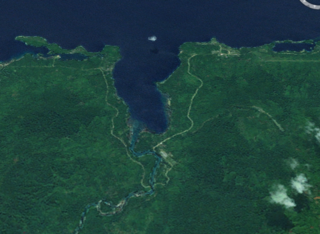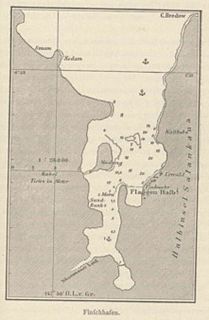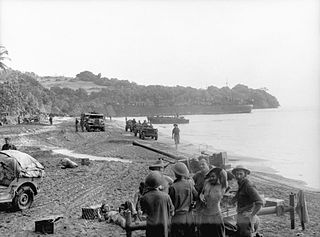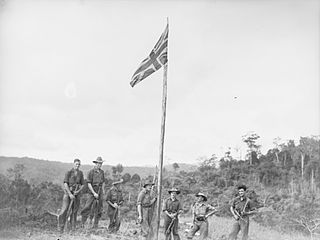
Milne Bay is a large bay in Milne Bay Province, south-eastern Papua New Guinea. More than 35 kilometres long and over 15 kilometres wide, Milne Bay is a sheltered deep-water harbor accessible via Ward Hunt Strait. It is surrounded by the heavily wooded Stirling Range to the north and south, and on the northern shore, a narrow coastal strip, soggy with sago and mangrove swamps. The bay is named after Sir Alexander Milne.

Morobe Province is a province on the northern coast of Papua New Guinea. The provincial capital and largest city is Lae. The province covers 33,705 km², with a population of 674,810, and since the division of Southern Highlands Province in May 2012 it is the most populous province. It includes the Huon Peninsula, the Markham River, and delta, and coastal territories along the Huon Gulf. The province has nine administrative districts. At least 101 languages are spoken, including Kâte and Yabem language. English and Tok Pisin are common languages in the urban areas, and in some areas pidgin forms of German are mixed with the native language.

Finschhafen is a district on the north-east coast of the Morobe province of Papua New Guinea. It is named after the port town of the same name, Finschhafen.

John Michael Bailey is an American psychologist, behavioural geneticist, and professor at Northwestern University best known for his work on the etiology of sexual orientation. He maintains that sexual orientation is heavily influenced by biology and male homosexuality is most likely inborn. Bailey wrote The Man Who Would Be Queen, a book intended to explain the biology of male sexual orientation and gender to a general audience, focusing on gender nonconforming boys, gay men and male-to-female transsexuals. The book elicited reactions ranging from strong criticism for its coverage of transsexuals, to a nomination for an award, later retracted, from the Lambda Literary Foundation, an organization that promotes gay literature.

The second USS Perkins (DD–377) was a Mahan-class destroyer in the United States Navy before and during World War II. She was named for George Hamilton Perkins.
Darren Dreger is a Canadian sportscaster for TSN, and currently serves as TSN's Hockey Insider. He had previously hosted Leafs Lunch on CFMJ AM640 Toronto Radio.

The Huon Peninsula campaign was a series of battles fought in north-eastern Papua New Guinea in 1943–1944 during the Second World War. The campaign formed the initial part of an offensive that the Allies launched in the Pacific in late 1943 and resulted in the Japanese being pushed north from Lae to Sio on the northern coast of New Guinea over the course of a four-month period. For the Australians, a significant advantage was gained through the technological edge that Allied industry had achieved over the Japanese by this phase of the war, while the Japanese were hampered by a lack of supplies and reinforcements due to Allied interdiction efforts at sea and in the air.

Finschhafen is a town 80 kilometers (50 mi) east of Lae on the Huon Peninsula in Morobe Province of Papua New Guinea. The town is commonly misspelt as Finschafen or Finschaven. During World War II, the town was also referred to as Fitch Haven in the logs of some U.S. Navy men.

The Dreger Clock is a large town clock with 19 different dials and displays which tell the local (California) time, the time in 12 international cities, the phase of the moon, the date and day of the week. It was built between the years of 1928 and 1933 by Andrew Dreger, Sr., a German immigrant to the United States, who was a blacksmith and watchmaker. The clock stood in front of his home in Long Beach, California for almost 20 years, until his death. It was then moved to Knott's Berry Farm in Buena Park, California, where it was enjoyed by visitors for over 50 years. The clock underwent restoration during the years 2008 and 2009 and when restoration was complete it was placed in the Buena Park Historical District in front of the Whitaker-Jaynes house as a historical reminder of the city's early years. The clock was installed on September 25, 2009.

Trégor is one of the nine traditional provinces of Brittany, in its northwestern area. It comprises the western part of the département of Côtes-d'Armor and a small part of the northeast of Finistère, as far as the river Morlaix. Its capital is Tréguier, the French translation of the Breton word Landreger.
The Sardinian Shepherd Dog or Fonni's Dog is an ancient landrace breed of Sardinian dog used as a herding, catching, and livestock guardian dog.

The Cane Paratore is a breed of herding dog from Italy, the breed primarily exists in its traditional role in Abruzzo, its historical region of origin, having not gained popularity from outside dog fanciers.

The Battle of Sattelberg took place between 17 and 25 November 1943, during the Huon Peninsula campaign of the Second World War. Involving forces from Australia, the United States and Japan, the fighting centred on the Sattelberg mission station which was situated atop a hill about 900 metres (3,000 ft) above sea level, approximately 8 kilometres (5.0 mi) inland from Finschhafen, New Guinea. Following the Australian landing at Scarlet Beach, a large force of Japanese had retreated inland towards Sattelberg. Holding the high ground, the Japanese subsequently threatened the Australian lines of communication as they proceeded to advance south towards Finschhafen, and in order to neutralise this threat, the Australian 26th Brigade was tasked with capturing the mission. Over the course of 10 days they advanced west from Jivevaneng up the southern approaches to the mission, reducing the Japanese position with armour, artillery and air support, before the Japanese finally abandoned Sattelberg and withdrew north to Wareo, having suffered heavy casualties and running low on supplies.

The Landing at Scarlet Beach took place in New Guinea during the Huon Peninsula campaign of the Second World War, involving forces from Australia, the United States and Japan. Allied forces landed at Scarlet Beach, north of Siki Cove and south of the Song River, to the east of Katika and about 10 kilometres (6.2 mi) north of Finschhafen. The capture of Finschhafen allowed the construction of air base and naval facilities to assist Allied air and naval forces to conduct operations against Japanese bases in New Guinea and New Britain.

The Battle of Finschhafen was part of the Huon Peninsula campaign in New Guinea during World War II and was fought between Australian and Japanese forces. The fighting took place between 22 September and 24 October 1943 following the landing at Scarlet Beach, which was followed by a two-pronged advance on Finschhafen as the Australian 20th Infantry Brigade advanced on the town from the north, while the 22nd Infantry Battalion drove from the south, having advanced from the landing beaches east of Lae. After the capture of Finschhafen, the Japanese forces in the area withdrew towards Sattelberg where they sought to hold the Australians before launching a counteroffensive, which subsequently threatened the landing beach. This attack was repelled by American and Australian forces, with heavy casualties being inflicted on the Japanese. In the aftermath, the Australians went on the offensive, capturing Sattelberg, and then advancing towards the Wareo plateau.

The Battle of Wareo was fought by Australian and Japanese forces in New Guinea during the Huon Peninsula campaign of World War II in the later part of 1943. Coming after the capture of Sattelberg by the Allies, the battle took place amidst the Australian advance north towards Sio. The Australians committed elements from four infantry brigades from the Australian 9th Division with supporting elements including artillery, engineers and tank support, while the Japanese force consisted primarily of two depleted infantry regiments from the 20th Division, with limited artillery support.

Lombrum Naval Base, also known as HMPNGS Tarangau and formerly PNG Defence Force Base Lombrum, is a naval military base operated by the Maritime Operations Element of the Papua New Guinea Defence Force (PNGDF). It is located on Manus Island in Papua New Guinea. Lombrum is the home port of the PNGDF's Pacific-class patrol boat force.

Alice Domurat Dreger is a historian, bioethicist, author, and former professor of clinical medical humanities and bioethics at the Feinberg School of Medicine, Northwestern University in Chicago, Illinois.

Galileo's Middle Finger is a 2015 book about the ethics of medical research by Alice Dreger, an American bioethicist and author. Dreger explores the relationship between science and social justice by discussing a number of scientific controversies. These include the debates surrounding intersex genital surgery, autogynephilia, and anthropologist Napoleon Chagnon's work.
Dreger is a surname. Notable people with the surname include:
















